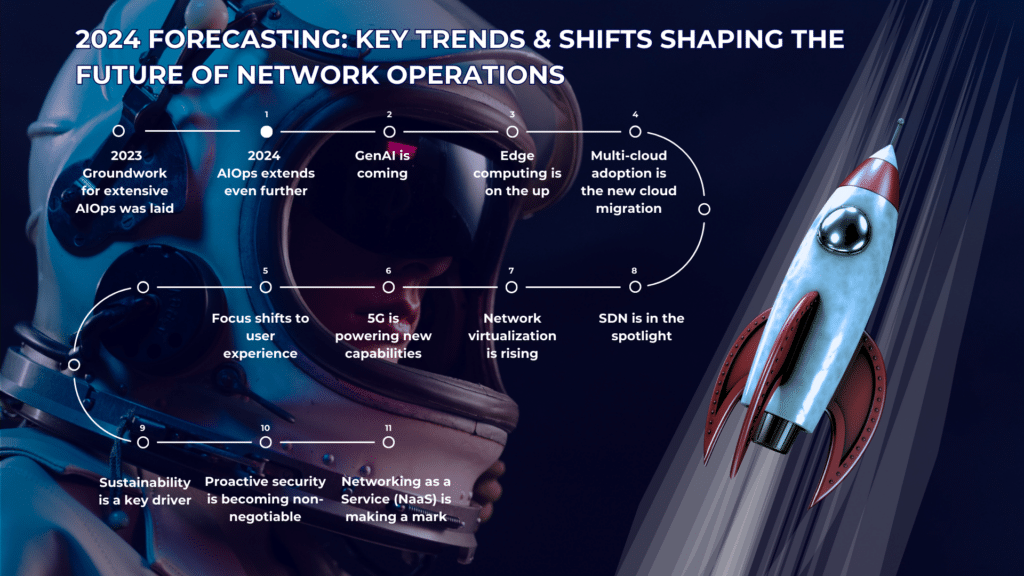2024 Forecasting: Key Trends and Shifts Shaping the Future of Network Operations

Networks have never been more important to business operations, and the pressure on network management is higher than ever. Users are demanding ceaseless connectivity and consistent performance, at the same time as networks grow more complex and extend far beyond the traditional LAN and into the cloud. Network management teams are coping with high demands while mastering new technologies and responding to changing trends. Against this backdrop, we’ve taken a careful look at the trends and changes that we expect to affect netops in 2024.
1. AIOps extends even further
Artificial intelligence (AI) is on the rise across industries. AI involves advanced computer systems that apply formulae called algorithms to scan and spot patterns within vast amounts of data, extracting information that they then apply to perform tasks that typically require human intelligence. AI is most often used for automation, analytics, and monitoring use cases. While AI isn’t a new trend for network operations management, it will dominate 2024 and for many years to come. The global AIOps market is expected to expand from $23.3 Billion in 2023 to $112.1 billion by 2032, at a CAGR of 18.5%. We will see it adopted more widely and in a greater number of situations, driven by the growing complexity and size of networks, together with increasing pressure for consistently excellent performance and uptime.
AI monitoring and Analytics
Some of the main use cases for AI will include predictive analytics and AI-powered performance monitoring, to meet rising expectations of high performance and high speeds at all times. One survey found that more than two-thirds of netops teams agree that AI-driven networking has improved end-user experience, with close to a quarter having seen a significant increase. Such solutions use machine learning (ML), a subset of AI, to constantly scan networks for anomalies and raise early alerts about intrusions or vulnerabilities, as well as providing deeper insights into network health that enable proactive improvements and resolution.
Recommended reading: Top 7 Benefits of Using AI for Network Monitoring and Operations
Network automation
At the same time, network management teams are seeing the benefits of AI for network automation. A recent Gartner report estimates that two-thirds of network tasks are manual. AI networking automates routine tasks and provisioning to minimize manual errors and support dynamic provisioning, making networks more resilient and robust. Today’s network monitoring solutions can automate problem resolution to enable self-healing networks, and as they grow smarter, they can make more intelligent suggestions to optimize network operations, resource allocations, and bandwidth utilization in order to improve end user experience. As networking adoption currently lies under 10%, according to Gartner, there is significant room for growth. The global network automation market size is forecast to grow from $3.57 billion in 2022 to $28.63 billion by 2032, at a CAGR of 23.14% that reveals the speed of predicted takeup.
AI-powered threat detection
Thanks to its ability to rapidly scan and analyze enormous datasets, AI threat detection is seeing increasing popularity. A survey by Arctic Wolf reported that 82% of cybersecurity decision-makers see AI as critical to security threat detection, investigation, and response in the near future, with 61% believing that AI will out-perform humans in this area. 64% of organizations expect to add AI technology to improve their cybersecurity readiness over the next year. Proactive AI threat detection uses behavioral analytics to examine data in real time and identify risk while they are still emergent.
2. GenAI is coming
Generative AI, or GenAI, applies AI algorithms to understand human speech and generate texts that rival those produced by humans. It has caused significant disruption, but thus far has had little impact on the network operations world. While we don’t predict an eruption of GenAI in the next 12 months, we do expect to see it enter and slowly spread in this sphere. One of the first ways that GenAI will affect network operations will be by easing interactions with new, innovative solutions. AIOps tools are often difficult to master and require technical knowledge of algorithmic science, which is holding back adoption. GenAI can help overcome this barrier, according to G2, thanks to its natural language interface which uses AI models that can understand and respond to regular human speech or texts. This allows users to communicate with the system using natural commands.
3. Edge computing is on the up
By bringing data storage and computing closer to the end user, edge computing reduces latency for data collection and analytics. It’s expected to see a surge in adoption in 2024, thanks to the role it plays in offering speeds that can support AI and automation. Accenture reports that 83% of companies believe that edge computing will be vital to their future competitive lead, as it makes possible the AI solutions that enable faster threat detection and resolution and better real-time network optimization.
We’ll also see increasing edge adoption causing a concurrent rise in the use of AI networking management and analytics, and it makes them more powerful and responsive. At the same time, edge computing brings new challenges. It opens up a more complex ecosystem where applications reside on numerous edges, pushing vendors to evolve networking strategies that can deal with a complex and segmented landscape.
4. Multi-cloud adoption is the new cloud migration
Cloud adoption is already a given. In 2024, we’ll see a continuation of the move to multi-cloud, as enterprises wish to access the strengths of different cloud providers, together with connected cloud, which links multi-cloud environments with on-prem privacy into a unified ecosystem.
These trends are raising new challenges around cloud security and integration. According to Cisco’s 2023 Global Networking Trends Report, 41% of networking professionals cited providing secure access to applications across multiple clouds as their top challenge. End-to-end visibility into network performance and security is the second-biggest issue, as traffic extends beyond the boundaries of the corporate network. Enterprise netops teams need to develop new strategies to eliminate blind spots so they can integrate clouds smoothly, ensure uninterrupted data synchronization, and maintain visibility and control over networks they don’t own as well as those they do.
5. Focus shifts to user experience
The ongoing pressure to deliver high performance, not just high uptime, is leading to a rise in user experience monitoring (UEM). 2024 will see more and more organizations apply predictive analytics and proactive security tools to prevent and resolve network issues before the end user experiences degraded performance.
Analysts at Gartner expect that by 2026, at least 60% of leaders in infrastructure and operations teams will be utilizing digital experience monitoring (DEM) to track services and performance from the perspective of the end user, compared with under 20% in 2021.
6. 5G is powering new capabilities
The rise in 5G goes hand in hand with edge computing. Together, they enable faster networks that deliver minimal latency, better network monitoring, more powerful predictive analytics, and advanced threat detection.
With 5G and edge computing, organizations can run massive devices, opening up new possibilities for augmented reality based on enormous Internet of Things (IoT) networks, as well as real-time data analytics that improve network optimization. McKinsey estimates that the number of connected devices will grow to 5.9 billion by 2025, predicting that this will drastically expand 5G telecommunication connectivity.
7. Network virtualization is rising
2024 is bringing a significant surge in the use of virtualized network services, such as routers, firewalls, and load balancers, with the global network function virtualization market forecast to reach $175.95 billion by 2029, growing at a CAGR of 23.63% between 2023 and 2029. Network virtualization is itself fed by the accelerating adoption of network automation, cloud services, data center consolidation, and server virtualization.
Virtualized network elements can run in the cloud, allowing network operations teams to access them from anywhere and handle network management tasks remotely. Virtualization helps reduce hardware costs, while also enabling smaller companies to pool resources by sharing hardware costs among many users.
8. SDN is in the spotlight
Software Defined Networks (SDN) adoption is both enabled by virtualization, and helping to drive the trend. With SDN, netops teams can carry out dynamic network configuration via independent software, allowing them to easily adjust current operations or add new ones without introducing new equipment or having to reconfigure hardware.
SDN supports automation, simplifies network management, and centralizes control to minimize manual configurations, resulting in more streamlined processes, fewer errors, lower costs, greater adaptability to changing needs. Thanks to these many benefits, the global SDN market is predicted to expand at a CAGR of 19.7%, from $24.5 billion in 2023 to $60.2 billion in 2028.
9. Sustainability is a key driver
Sustainability is a rising concern for every industry, resulting in pressure on every department to contribute towards the organization’s overall sustainability profile. Networks and IT needs can guzzle energy, making every movement to reduce it significant for reasons of both sustainability and cost. NTT DATA’s 2022–23 Global Network Report found that companies that aligned their network strategy with their business needs are close to three times more likely to lower their environmental footprint than those that have not.
As a result, we’re seeing enterprises increasingly using AI monitoring to track energy use, alongside network automation that helps ensure that networks are as energy-efficient as possible. AI analytics can calculate when it’s possible to drop network speeds in order to conserve energy, without affecting end user experience.
10. Proactive security is becoming non-negotiable
An alarmingly steep rise in DDoS attacks is pushing businesses to adopt new proactive security measures that can identify unusual traffic patterns and divert malicious traffic before an attack can occur. These include ML-powered continuous monitoring, which can spot threats before they grow serious, and zero trust security, particularly zero trust edge (ZTE), which merges WAN and security in a cloud system. Zero trust is still in the early adoption stage, but we predict that it will grow more important over the years.
11. Networking as a Service (NaaS) is making a mark
Networking as a Service, or NaaS, is seeing growing popularity. Much like Software as a Service (SaaS) before it, NaaS provides flexibility, adaptability, lower costs, and easier scaling without extensive capital commitment. Admittedly, adoption is still in its early stages, with Forrester pointing to confusion about its nature hindering adoption. However, NaaS is likely to grow significantly over 2024 and beyond, as ABI Research predicts that by 2030, over 90% more enterprises will use NaaS for at least 25% of their network services.
Summary: 2024 will be the year of AI in network operations
The next 12 months will see the adoption of a lot of new technology that helps streamline and simplify network operations management, much of it including or driven by some form of AI. Across a number of different use cases, AI is arriving to improve network management, performance, and security. The challenge for netops teams will be to find the right tools, master their capabilities, and ensure that they play well together and with the enterprise’s existing infrastructure.


